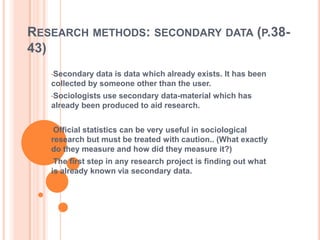
Research Methods: Using Secondary Data
- 1. RESEARCH METHODS: SECONDARY DATA (P.38- 43) •Secondary data is data which already exists. It has been collected by someone other than the user. •Sociologists use secondary data-material which has already been produced to aid research. •Official statistics can be very useful in sociological research but must be treated with caution.. (What exactly do they measure and how did they measure it?) •The first step in any research project is finding out what is already known via secondary data.
- 2. TYPES OF SECONDARY DATA Quantitative secondary data: Official statistics (eg Census, General Household Survey etc) Qualitative secondary data: personal documents, political letters, life histories, autobiographies, official documents, novels, mass media (newspapers, magazines, television, radio)
- 3. OFFICIAL STATISTICS Government/official bodies produces large amounts of quantitative data (official statistics) For example: No of births, deaths, marriages, divorces Census information Crime and unemployment rates Social Trends The General Household Survey
- 4. Examples of Official Statistics
- 5. OFFICIAL STATISTICS Hard Statistics Statistics which are not affected by decisions of those collecting them. Few people missed out in the final count. (eg births, deaths) Soft Statistics Process of how they are collected affects the results: Eg.Crime rate may only include number of reported crimes Eg. Levels of unemployment may include different groups at different times
- 6. OFFICIAL STATISTICS Invaluable for sociologists Include large samples, cover many areas of social life, expensive to carry out Often well-planned and of high standard Access easy (find them in libraries/internet) Good for making comparisons over time Don’t always measure what you want Sometimes manipulated for political reasons (eg unemployment rates, crime rates etc) When poverty rising, government sometimes stops collecting data Embarrassing results may not be published Cannot be sure that official statistics are always valid While official statistics often tell you how much they don’t tell you why Check out http://statistics.gov.uk Strengths of official statistics Limitations of official statistics
- 7. QUALITATIVE SECONDARY DATA Personal documents such as diaries, letters, (even household bills, wills, shopping lists) Life histories and autobiographies Official documents Novels Mass media including newspapers, t.v.,radio, internet, magazines, film.)
- 8. HOW IS QUALITATIVE SECONDARY DATA USED? Personal Documents Used most often by sociologists Need to assess if they were meant to be read by wider audience (therefore may be filtered for information, may give good impression of writer) If not meant to be read by public, while more likely to be valid, they are difficult to get hold of People sometimes asked to keep diaries to accompany research (interview or questionnaires) Eg ‘Mass observational research’ 1930s (See p.42) ‘The Polish Peasant in Europe’ Thomas and Zaniecki
- 9. Examples of qualitative secondary data
- 10. LIFE HISTORIES AND AUTOBIOGRAPHIES Life histories People’s own accounts of their lives Rely on memory therefore need to be validated through checking with other sources at time (newspapers etc) Requested by researcher Autobiographies Not requested by researcher Can give insight into social life at time May be concerned with making good impression so may not provide frank , honest account of life Memory may be faulty/incomplete
- 11. OFFICIAL DOCUMENTS Governments produce documents (not just statistical information) of many types Some documents are made public after a number of years (30-100 years) after which time they are no longer deemed ‘sensitive’ Most documents are available to the public right away (in UK Acts of Parliament, reports by Comissions etc)
- 12. MASS MEDIA Provides a vast amount of material of interest to sociologists Can be used as part of preliminary research for a topic to be researched (eg watching documentary/ reading newspaper articles on a specific topic) Researcher needs to be aware as material may be biased or focus on limited areas of topic. Media can be studied as a topic itself (eg how ethnic minorities/women are shown in media or is the newspaper biased towards one political viewpoint) Media can be analysed quantitatively (content analysis) See p.43
- 13. NOVELS Novels, plays or short stories often explore social issues which may be analysed by sociologists They can portray life accurately at a particular time and place. Difficult for the researcher to separate social fact from imagination What might we learn from ‘Oliver’ by Charles Dickens?/ ‘Emma’ by Jane Austin? ‘The Help’ by Kathryn Stockett? Choose a novel you have read. How might it be useful to sociologists? What social issues does it tackle? What does it tell you about the time and place it was written on?
- 14. EXAM QUESTIONS: PRACTICE What is meant by the term ‘personal documents? /2 What is meant by the term ‘secondary data’ /2 Describe one strength and one limitation of secondary data. /4 Describe one strength and one limitation of using personal documents in sociological research. /4 Describe two problems that might arise when using historical documents in sociological research. /4 Describe two strengths and two limitations of using official statistics in sociological research. /8